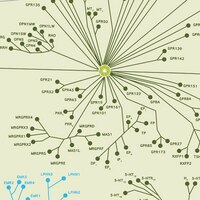HTS065M Sigma-AldrichChemiSCREEN™ Membrane Preparation Recombinant Human MT1 Melatonin Receptor
Human MT1 GPCR membrane preparation for Radioligand binding Assays & GTPγS binding.
More>> Human MT1 GPCR membrane preparation for Radioligand binding Assays & GTPγS binding. Less<<Produits recommandés
Aperçu
| Replacement Information |
|---|
Tableau de caractéristiques principal
| Species | Host Cells | Protein Target |
|---|---|---|
| Human | Chem-1 | MT1 |
| References |
|---|
| Product Information | |
|---|---|
| Format | Membranes |
| Presentation | Liquid in packaging buffer: 50 mM Tris pH 7.4, 10% glycerol and 1% BSA with no preservatives. Packaging method: Membranes protein was adjusted to the indicated concentration in packaging buffer, rapidly frozen, and stored at -80°C. |
| Quality Level | MQ100 |
| Physicochemical Information |
|---|
| Dimensions |
|---|
| Materials Information |
|---|
| Toxicological Information |
|---|
| Safety Information according to GHS |
|---|
| Safety Information |
|---|
| Storage and Shipping Information | |
|---|---|
| Storage Conditions | Maintain frozen at -70°C for up to 2 years. Do not freeze and thaw. |
| Packaging Information | |
|---|---|
| Material Size | 200 units |
| Transport Information |
|---|
| Supplemental Information |
|---|
| Specifications |
|---|
| Global Trade Item Number | |
|---|---|
| Référence | GTIN |
| HTS065M | 04053252733970 |
Documentation
Références bibliographiques
| Aperçu de la référence bibliographique | Nº PubMed |
|---|---|
| Overexpression of the MT1 melatonin receptor in MCF-7 human breast cancer cells inhibits mammary tumor formation in nude mice Collins, A, et al Cancer Lett, 189:49-57 (2003) 2003 | 12445677
 |
| Involvement of the mt1 melatonin receptor in human breast cancer Ram, P T, et al Cancer Lett, 179:141-50 (2002) 2002 | 11888668
 |
| Melatonin receptor signaling: finding the path through the dark Masana, M I and Dubocovich, M L Sci STKE, 2001:PE39 (2001) 2001 | 11698691
 |









